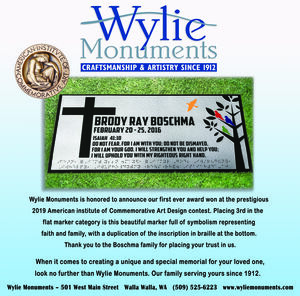Home Emergency Care
Topic of the Month: rattlesnake bite
May 30, 2019
When a medical emergency occurs the City of Waitsburg and its surrounding homes and farms face challenges, as do all rural areas, in EMS response times and transport times to an emergency room. This monthly column, written by former firefighter and paramedic Randy Charles, is aimed at providing area residents, who are faced with a medical or traumatic event, some kind of knowledge and skills that can be utilized to help a stricken individual while waiting for EMS.
OVERVIEW
Spring is here and summer is around the corner. The sun is out (sometimes), schools out (soon), and it’s time to be outside enjoying the beauty of the Palouse and Blue Mountains. We all know that as the summer weather arrives, our little buddies, the Western Rattlesnake, become active. Fortunately there are no other venomous snakes we have to deal with in the northwest (no Coral Snakes, Water Moccasins, Copperheads, etc.) so that is GOOD!
FUN FACTS
Western Rattlesnakes:
Are not found in western Washington, they apparently recognize what a great place eastern Washington is to live…lucky us.
Are commonly encountered in proximity to their dens, often among the rocks to access sun exposure.
Are active spring through fall.
Sizes ranges from 18 inches (juveniles) to 4 feet (adults).
Have wide triangular-shaped heads
Diamond-shaped pattern of scales on the back
Color varies with habitat, ranging from grey to greenish-brown.
A rattle at the end of their tail (I presume this is not a surprising revelation).
They don’t always rattle before they strike or strike after they rattle.

They are unlikely to strike humans unless they feel threatened.
This is a really FUN FACT: Rattlesnake bites are rarely fatal to humans, but they are painful and can cause swelling and tissue damage.
Note: Dogs are about 20 times more likely to be bitten by venomous snakes than people and are about 25 more likely to die if bitten…its best to keep them on a leash but if they are bitten get them to a vet ASAP.
AVOID BEING BITTEN
(I know, this is a really obvious thing to do but prevention is much better than treatment)
Wear boots and jeans
Be very careful where you place your hands…this is the most common location of a bite. (Using a sling to immobilize the arm of the bitten hand is good idea.)
IF BITTEN
Despite what you see on TV and in movies or have learened in previous training, that may have been updated, DO NOT:
Make incisions over the wound
Restrict blood flow or use a tourniquet
Ice the wound
Suck the poison out with your mouth
Note: commercial snake bite kits are generally viewed as ineffective
Drink caffeine or alcohol, this could speed your body’s absorption of venom.
Try to capture the snake. Try to remember its color and shape so that you can describe it, which will help in your treatment.
DO:
Stay calm, don’t panic; its ok to walk out to your car, but take it slow and easy, don’t increase your heart rate (Calm…)
Call 911 or get to an ER
Keep the wound clean; apply a clean, dry bandage.
Remove watches, rings or anything else that may constrict swelling
Immobilize the area if possible (if bitten on hand or arm utilize some form of sling).

Keep the bite BELOW the level of the heart.
Have a great and safe summer!


Reader Comments(0)